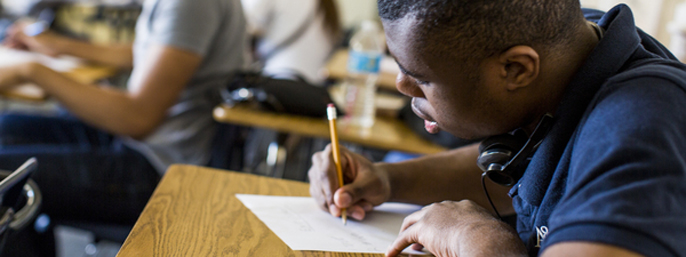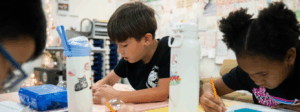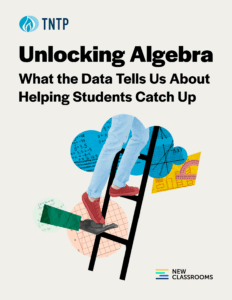If you want a surefire way to dampen the mood at a party or heighten the tension at your dinner table, bring up standardized testing. It’s the part of our education system everyone loves to hate. In the last few weeks alone, we’ve seen stories from across the country spotlighting parents’ and teachers’ concerns about standardized tests—above all, the worry that students spend too much time every year taking them. It’s a legitimate concern. My two kids attend public schools, and I want them to spend as much time as possible learning from amazing teachers—not taking tests.
I also understand that tests are an important part of learning, even if nobody really loves them. I can’t help my kids—and their teachers can’t help them—if we don’t know what they have or haven’t learned. Tests and quizzes have always been an important tool for teachers, and research shows they have real educational value.
Standardized tests have been around for decades for the same reason: done right, they’re an important source of information to parents about whether our kids are on track for success in school. They also help us identify larger trends like where some groups of kids are falling behind, which districts and schools are helping kids overcome challenges, and which ones are not. Done wrong, they don’t provide any useful information on whether kids are learning what they need to succeed.
Traditionally, states have mostly done testing wrong. They’ve used poorly designed tests and set such a low bar that many kids got passing grades in spite of the fact they hadn’t learned the skills they need to graduate high school prepared for college or a career.
Now, many states are attempting to improve tests by adopting learning standards designed to provide a roadmap for kids to be ready for college by the end of high school, and tests that provide a much better measure of whether kids are on track for success. These new tests inevitably will mean lower scores for kids, schools and districts. Not surprisingly, there has been a huge backlash. However, the opposition focuses less on the quality of the tests and more on the idea that federal policy requires schools to spend more time than they should on tests and test prep, crowding out time for instruction and enrichment activities.
Which begs the question: how much time does Uncle Sam really make students spend taking tests and prepping for them?
The answer? Less than you might think. Out of nearly 2,300 school days a student has from kindergarten through twelfth grade, the federal government requires students to take tests on just 17 of them—less than one percent of the time. I doubt very many parents would find that to be excessive, but that’s only one aspect of the issue.
Many advocates against testing claim schools and districts react to test-based accountability by wasting time on mindless test prep. It would be worthwhile to try to study how much time is actually being taken up with these activities.
No doubt it is excessive in at least some places. But we should agree on a couple of things: first, test prep, and certainly useless test prep, isn’t mandated by federal or state governments. If it’s happening, it’s based on district or school policies. Second, bad test prep, like having kids take practice tests over and over, doesn’t work. If a fourth grader can’t read well enough to understand, analyze and write about a short non-fiction article, all the practice tests in the world won’t help her.
Bad test prep is just one form of bad instruction. How many schools now choosing to do mindless test prep would be providing excellent instruction to those same kids if there were no tests at all? I’d venture not many. We should fight mindless test prep, for sure, because it’s as soul-crushing for educators as it is for kids, but we should be no less outraged about other forms of bad instruction that do a disservice to students. If you’re mad about drill-and-kill test prep sessions, you should be steamed about Friday movie days, too.
Then there is another aspect of the issue that rarely gets talked about. There are a slew of additional tests required by states, school districts and individual schools on top of those mandated by the federal government. Some of these tests provide useful information to parents and educators about student mastery of critical material—like the PSAT—but others aren’t aligned to coursework and only waste time and resources. Notwithstanding the debates over Common Core, we can all agree that eliminating this category of tests would be a positive step.
State superintendent and education commissioners are well positioned to work with district leaders to lay everything out on the table for their communities: exactly how many standardized tests students are required to take, which level of government requires them and what information each test is supposed to provide to teachers and parents. Once communities have the facts about how much testing is actually required, they can have an informed conversation about which tests we could do without.
One state has already done this audit of their standardized tests, with promising results. Florida’s State Education Commissioner, Pam Stewart, called on district superintendents across the state to identify the standardized tests their schools administer, how much time they require and why students are required to take them. As a result, Stewart was able to make several recommendations to ease the burden on teachers and students, including one to eliminate local final exams in courses where there is also a statewide, standardized end-of-course exam.
I think we can see similar results across the country if other school superintendents are willing to show the same kind of leadership. If so, we can all spend less time worrying about tests, and more time worrying about teaching.







